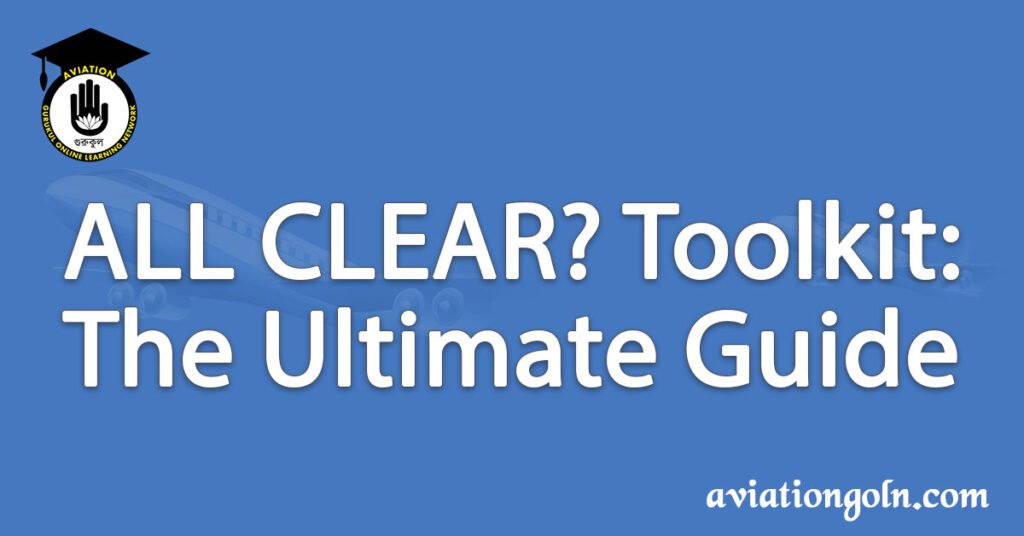ALL CLEAR? Toolkit: The Ultimate Guideছ Navigating through a project, whether it’s in the realms of IT, marketing, event management, or any other sector, requires clarity and structure. The success of your project depends on your ability to communicate effectively, set clear expectations, and ensure everyone is on the same page. Enter the “ALL CLEAR? Toolkit” – your one-stop solution for ensuring clarity and avoiding ambiguities.
ALL CLEAR? Toolkit: The Ultimate Guide
What is the ALL CLEAR? Toolkit?
The ALL CLEAR? Toolkit is a conceptual framework that helps teams and individuals ensure clarity in their projects. It focuses on aspects that ensure clear understanding, communication, and decision-making among all participants. By addressing potential ambiguities and misunderstandings at the earliest stages of a project, the toolkit aids in preventing missteps and streamlining the path to success.
Components of the ALL CLEAR? Toolkit
Let’s dissect the ALL CLEAR? Toolkit and delve into its integral components:
1. Assessment
Every endeavor begins with a clear assessment. This step involves understanding the problem at hand, the objectives you’re trying to achieve, and the resources you have available. Questions to consider include:
- What is the main problem or challenge?
- What are our project objectives?
- Who are the stakeholders?
- What resources (time, money, personnel) do we have?
2. Listening
One of the most overlooked yet crucial steps is active listening. Ensure that all team members and stakeholders are given an opportunity to express their views, concerns, and ideas. By creating a platform where everyone feels heard, you are building a foundation for effective collaboration.
3. Learning
After listening comes the phase of learning. This is where the team gathers all necessary information about the project. This can include studying market trends, understanding consumer behavior, technological research, and so on. Continuous learning also implies adapting and evolving as new data or challenges emerge.
4. Clarity
The entire essence of the ALL CLEAR? Toolkit is to achieve clarity. Ensure that all instructions, roles, responsibilities, and expectations are crystal clear. Remove any jargon or overly technical terms that might be confusing. When communicating, always double-check to ensure your message was understood as intended.
5. Expectation Setting
A common reason projects fail is because of misaligned expectations. Clearly define what the outcomes should be and by when. This doesn’t only apply to the end results but also to minor milestones throughout the project. Ensure all team members know what’s expected of them.
6. Action Plan
With clarity and expectations set, it’s time to create a tangible action plan. This plan should be detailed, with tasks, timelines, and responsible individuals or teams assigned to each task. This plan serves as the roadmap for the project.
7. Review
Regularly review the progress of the project. Check if the team is following the action plan and meeting the set expectations. This is also an opportunity to identify any roadblocks or challenges and address them in real-time.
8. Feedback Loop
Establish a continuous feedback loop. This ensures that any issues, whether they’re with the project’s progress or within the team dynamics, are addressed promptly. A feedback loop also allows for the iterative improvement of processes and strategies.
Benefits of the ALL CLEAR? Toolkit
Improved Communication
By emphasizing listening, clarity, and feedback, the toolkit fosters an environment where communication is open, honest, and effective.
Better Resource Management
With clear objectives and an action plan in place, resources such as time, money, and manpower can be allocated and used more efficiently.
Reduced Conflicts
By setting clear expectations and establishing a feedback loop, potential conflicts can be identified and addressed before they escalate.
Increased Accountability
With everyone having a clear understanding of their roles and responsibilities, there is a higher sense of accountability, leading to better outcomes.
Enhanced Adaptability
Regular reviews and continuous learning mean that the team is better equipped to adapt to unforeseen challenges or changes in the project landscape.
Implementing the ALL CLEAR? Toolkit
- Workshop Introduction: Begin with an introductory workshop. Educate the team about the toolkit and its importance.
- Engage Everyone: The toolkit is most effective when everyone is involved. From senior leadership to interns, everyone should be aligned with the ALL CLEAR? principles.
- Use Visual Aids: Visual aids, like flowcharts or diagrams, can be helpful in illustrating processes, setting expectations, and ensuring clarity.
- Consistent Check-ins: Regularly check in with the team. This could be daily huddles or weekly meetings, depending on the project’s nature and duration.
- Feedback Surveys: Use anonymous surveys to gather feedback. This way, team members may feel more comfortable sharing concerns or suggestions.
- Iterate and Improve: Remember that the implementation of the ALL CLEAR? Toolkit is also a process that can be refined. Gather feedback and make necessary adjustments to the approach.
The ALL CLEAR? Toolkit is not just a project management tool; it’s a philosophy. It emphasizes the importance of clarity in all aspects of a project, from initial assessment to the final review. When everyone is clear about the objectives, roles, expectations, and challenges, the path to project completion becomes smoother, more efficient, and free of avoidable pitfalls. Implement the toolkit in your next project and experience the difference it makes!
See more:

